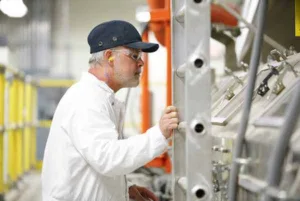For many years, or better, decades, it has been a clear business understanding that political influence over business decisions will never work. Even though there were examples of short term success , the long term outlook always saw businesses succeeding by lowering cost and increasing sales.

One of the longest experiments to upset this paradigm of market economies was the communist ideology in Eastern Europe and other parts of the world. As it has turned out, there is not much left in terms of communistic political and economic systems around the world.
So, when the USA tried to force US-based companies to make investment decisions with a more nationalistic view, many thought this not would work at all. The idea of threatening companies with tariffs, taxes or any other controlling process didn’t really go over so well, until the current US government threw in a potentially lower corporate tax rate for top companies. Nobody wants to pay taxes and international companies have a lot of leeway on where to realize their profits and pay taxes.

What is playing out right now in front of us is the reaction of industrial companies responding to the carrot in front of them. The greatest example is the ‘Advanced Manufacturing Fund’ that Apple announced some time ago to support US-based companies. They pledged to give up to $1 billion to US-based companies in return for what? Some analysts say in return for a lower corporate tax rate.
This is by no means as crazy as it sounds. Reuters stated in an article that Tim Cook stopped short of saying that Apple would bring back some money to the US (94% of their free cash seems to be sitting in other countries) if the tax rate was lowered, but he said “Apple would have to borrow the cash for its U.S. manufacturing investment fund and said he was hopeful Trump would address the repatriation issue.”
While all this sounds like a typical political deal, taking place largely behind closed doors, the really interesting part lies in the fact that Apple did borrow the money and just announced the first recipient of a grant from this fund. To everyone’s surprise the recipient is Corning, which is receiving $200 million for improvement to its Harrodsburg plant. The grant is expected to be used to create a state of the art glass manufacturing line in the USA.
Corning glass manufacturing in Harrodsburg – from Apple press release
Corning is by no means a small company. Their 2016 sales totalled $9.4 billion with a net income of $1.3 billion. If the Apple grant was needed to make Corning competitive in a certain field, one would immediately think of display glass. Here is the catch, Harrodsburg was one of the factories that developed the overflow fusion process that gives Corning an advantage in the display market, but the manufacturing went to Asia many years ago. So what is there today is most likely not state of the art by today’s standards, but without a display manufacturer committing to a US based LCD or OLED plant why would Corning build a state of the art glass plant in the US? And even more baffling is the question why Apple would invest into this?
If there is anyone out there that believes that Apple is investing $1 billion to help other people without a chance to benefit from the investment in return, I want to shake your hand. It is not often that you meet an idealistic optimist in business!
The question is what is Apple expecting to get in return and why do they want this to happen in the USA? There are several ideas floating around at the moment. One is the idea of a better glass to protect their mobile devices and the other is that they may want to get back to a smartphone back of glass or ceramic material to enable wireless charging.
While both ideas have a good ring to them, I do not understand why this investment would be helpful in an US-based factory. Corning does not actually manufacturer display glass in the US but has many factories in Asia. If this is just an R&D facility to develop new processes, why use the investment from an ‘advanced manufacturing’ fund? Of course, there are materials and glass compositions that would be good solutions for such topics and some of them may be difficult to manufacture, but still this doesn’t sound right to me.
Another idea would be to create a new substrate for Apple’s micro LED display activities. These will first serve the Apple Watch, a product that could be manufactured in the US (at least partially) and require less material as the displays are small and the quantities not as large as the iPhone. We know very little about the micro LED process that Apple is looking at and therefore we have no idea if the current glass products are sufficient or not. For example, how much waviness in the glass substrate can the micro LED manufacturing process accept. Do they need to grind and polish the surface before the process works? All these question could require a new manufacturing process on Corning’s end. If this is true, a $200 million investment makes a whole lot of sense. Especially if, in return, the corporate tax rate goes down significantly.
The real question that the next generation of analysts has to answer is the question of “whether this time politics actually beat business”. (NH)

